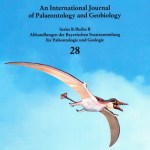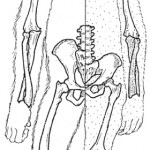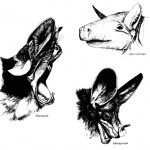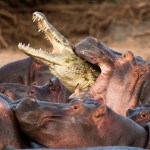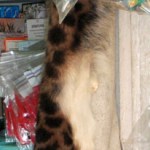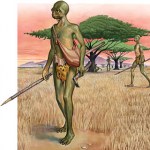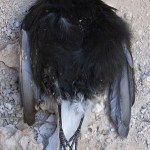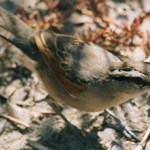On Monday 7th December the Zoological Society of London (ZSL) hosted the one-off event 'The Secret World of Naked Snakes' (part of the ZSL's 'communicating science' series): a whole meeting devoted entirely to those bizarre, poorly known, limbless, worm-like amphibians, the caecilians. The meeting was attended by over 100 people, which really isn't bad going, especially when some of the organisers expressed fears that the event would only be attended by (to quote David Gower) "A handful of caecilian freaks".
Ken Livingstone [shown here] - former Mayor of London and well-known amphibian…

No time for anything substantive lately, though thoughts on the ZSL caecilian meeting coming up soon. Meanwhile, here's another short article in the 'over-enthusiastic swallowing' series: note that the articles aren't all about cases where animals choke to death. Some of them concern cases where the animals swallow insanely large objects, and still live to tell the tale. This time round, we look at the case of Mushu, a pet Central bearded dragon Pogona vitticeps, who was noted by her 7-year-old owner (Finley Collins) as having something unusual protruding from her vent.
Finley was (according…
It's well known that herons are gluttonous birds that will catch and eat (or try to eat) pretty much any animal within the right size range. Everyone knows that herons eat fish, but they also eat frogs, snakes, small mammals (including rodents and rabbits), and birds including doves, grebes and ducklings. We previously looked at a rabbit-eating Great grey heron Ardea cinerea here. I'm actually intending to talk about herons and their feeding behaviour at length at some stage; not today though.
Over-enthusiastic attempts to swallow large prey items have resulted in various recorded heron…
In case it isn't obvious, I've decided to do a little series on 'over-eager swallowing'. And here's the latest instalment. Here's an unfortunate Perentie Varanus giganteus that died after trying to swallow a Short-beaked echidna Tachyglossus aculeatus...
The photo is from Kirschner et al. (1996), and the accompanying text is...
Auch freilebende Warane können sich einmal verschätzen. Dieser Riesenwaran wurde Opfer seiner Gier. Beim Versuch, einen Stacheligel zu fressen, fügte er sich tödliche Verletzungen zu.
... which basically says that the lizard was a victim of its own greed, and died…
Continuing with the theme of over-eager swallowing of large prey, I thought I'd share the following case, reported in the literature by Clark (1967). A Horned or Sand viper specimen belonging to the subspecies Vipera ammodytes meridionalis (sometimes called the Eastern sand viper) was caught on the Greek island of Euboia. It looked fat at the time of collecting, and died an hour later.
Dissection revealed what you see in the photo: this small snake had eaten, whole, a centipede 140 mm long. Wow, ambitious. While the possibility exists that handling and subsequent bagging somehow damaged the…
After a little delay, it's time to embark once more into the World of Toads!!! Having previously looked at toads in general, and at the toads of Europe, we here continue the series by looking at yet more familiar, northern toads: this time at those of North America.
As with some of the other 'northern' toads we've looked at (the Natterjack and the Green toad and its relatives), North America's many toad species have conventionally been subsumed into the anuran genus-that-ate-the-world, Bufo. However, genetic studies have shown that the North American toad clade that includes the Common…
Carnivorous animals often die from choking, and field biologists have done a good job of recording many such instances in the literature.
This image shows an unlucky young Roadrunner Geococcyx californicus found dead in Brisco County, Texas, in 1998. The bird had tried swallowing a Texas horned lizard Phrynosoma cornutum, and things clearly went horribly wrong. Other instances of this sort of thing are on record. Remind me to post the goanna vs echidna photo some time. The photo used here is from...
Holte, A. E. & Houck, M. A. 2000. Juvenile Greater roadrunner (Cuculidae) killed by…
Congrats yet again to Sterling Nesbitt and colleagues on the publication of another one of those insane Triassic hellasaurs, this time the surreal archosauriform* Vancleavea campi (Nesbitt et al. 2009) [adjacent life restoration by Sterling Nesbitt]. Vancleavea was named by Long & Murry (1995) and is well represented by various bits and pieces from the Upper Triassic of the southwestern USA (interestingly, it seems to have been around for a long time: like, 20 million years or so). Its affinities were initially unclear: all that was clear was that it was a weird, armoured diapsid reptile…
Long-time readers will recall my few articles about the Peter Wellnhofer pterosaur meeting [see links below], held at the Bayerische Staatssammlung für Paläontologie und Geologie (Bavarian State Palaeontological Collection - BSPG) in Munich in 2007. The meeting, organised by Dr Dave Hone, was attended by most of the world's pterosaur workers, and was planned to be the first in a series of regular events (the next pterosaur meeting is due for 2010, and will be held in Beijing).
The plan back in 2007 was to produce a special tribute volume of the BSPG's in-house technical journal (Zitteliana…
I had to scan some hominid pictures today; came across this old classic and thought it worth using here.
Produced by Adrienne Zihlman, the picture has been used to support Zihlman's 'pygmy chimpanzee hypothesis' (Zihlman et al. 1978): this being the idea that the Bonobo Pan paniscus is 'the best prototype for the common ancestor of humans and [other] African apes' (Zihlman 1984, p. 39). Many recent discoveries have shown that at least some australopithecines really were more chimp-like than used to be thought, and the old idea that fossil hominins were just prototype versions of Homo is now…
As a Tet Zoo regular you'll know and love the remarkable limbless amphibians known as caecilians.
In case you don't know, caecilians have sensory tentacles, sometimes have protrusible eyes, sometimes lack eyes entirely, often exhibit sophisticated parental care [maternal skin-feeding is going on in the middle image above], are incredibly long-bodied yet often lack tails, sometimes possess large, anatomically complex, eversible male sexual organs, and so on and so forth. Should you need to know more, please visit the links below. Due to their fossorial habits, a very confused taxonomic…
My good friend Luis Rey was kind enough to pass on the following photos, taken at the Jardin Des Plantes in Paris. It's the extinction carousel, (presumably) the only place in the world where you might ride a sivathere...
... or a meiolaniid, or an elephant bird...
... or a dodo...
Yes, yes, I know that the creatures aren't totally accurate (the meiolaniid in particular), and if you know your extinct animal artwork you'll have realised that the animals are all based directly on the paintings that Eric Alibert produced for Jean-Christophe Balouet's 1990 book Extinct Species of the World:…
Time only for a picture-of-the-day post... here are portraits of the big animalivorous microbats Otomops (a molossid, of course*), Cheiromeles (also a molossid) and Vampyrum (a phyllostomid). The pic is from Freeman (1984), but you might notice that two of the drawings are based on the photos featured in Walker's Mammals of the World.
* I say 'of course' as the 'mops' part of the name is strongly associated with this group of bats (popularly known as mastiff bats or free-tailed bats). Besides Mops itself (the greater mastiff bats), there's Platymops, Neoplatymops, Cabreramops, Otomops,…
You've probably seen - presumably on TV - Nile crocs Crocodylus niloticus interacting with Common hippos Hippopotamus amphibius (if you've seen it in real life, lucky you). By and large the two seem to keep apart. Having said that, there are certainly photos of the two sharing the same sandbanks. And then there are those instances of hippos scaring crocs away from carcasses, the weird reports of hippos mouthing and chewing the backs and tails of resting crocodiles, and those cases where crocodiles have been seen to walk or run across hippos' backs.
What can certainly be said to be the most…
By now you might have read my two previous articles (part I, part II) on the assorted tetrapods I encountered in Libya last month. Here's the third and final part in the series [image below shows chital at left, melanistic fallow top-centre, nilgai bottom-centre, blackbuck at right].
It's a bit unusual for a Tet Zoo article, as it contains a whole paragraph of boring travel-writing stuff, but I hope you can grit your teeth and get through this - the meat and potatoes on obscure subspecies and so on is delivered towards the end, I promise. So, without further ado...
Having spent our time in…
Regular readers will know that I'm not exactly a fan of the idea - discussed here and there in the technical (Russell & Séguin 1982, Russell 1987), popular (Hecht 2007, Socha 2008, Naish 2008) and speculative literature (McLoughlin 1984, Magee 1993) - that non-avian theropod dinosaurs might have evolved into humanoids had they not bought the farm 65 million years ago [image below by Matt Collins].
The hypothetical (emphasis: hypothetical) evolution of big brains, intelligence and so on among imaginary post-Cretaceous deinonychosaurs is not (in my opinion) all that unreasonable, and I…
After a little delay, I'd like to continue regaling you with, if I may, my assorted musings on my excursion to the Great Socialist People's Libyan Arab Jamahiriya. In other words, I want to talk more about Libya...
In the previous article I spoke about some of the animals I saw both in the more urban areas, and out in the countryside. If you go to north Africa (and if you're interested in ornithology), you hope to see larks. Larks (alaudids) do well in the deserts and semi-deserts of the region, and there are lots of species to see, some of which are very, very neat. If you think not, you're…
My wife gives money to a cancer charity. She gets literature of some sort for doing this, and here's the front cover of the Christmas booklet she recently received. Why, as a Tet Zoo nerd, do I find it so funny?
Goddammit, no time for more reports from Libya, or for more in the toads series, or for articles on hairless Spectacled bears or tiny heterodontosaurids or neovenatorids, or anything really. Here's how things are progressing in view of Saturday's event...
Well done if you can work out what the hell's going on here. I know that some of you can.
So, I recently returned from a brief sojourn in Libya. The trip was led by Richard Moody, best known for his work on Cretaceous sea turtles; I was also accompanied by palaeornithologist Gareth Dyke and by a group of people interested in the country's geology.
Libya - officially, the Great Socialist People's Libyan Arab Jamahiriya - is huge: it covers nearly 2 million square kilometres and is the fourth largest African county. However, 90% of the country is desert, and the population is only about 5.7 million (of which nearly 2 million live in Tripoli, the capital). It's a land of…







